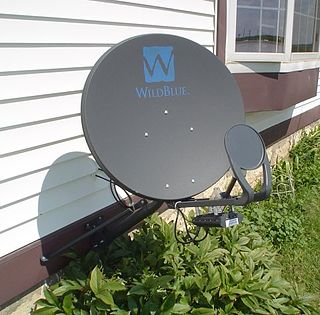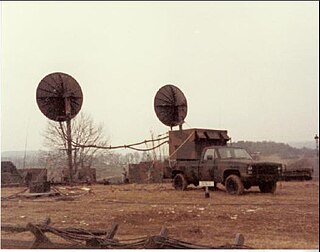
Digital Enhanced Cordless Telecommunications (DECT) is a cordless telephony standard maintained by ETSI. It originated in Europe, where it is the common standard, replacing earlier standards, such as CT1 and CT2. Since the DECT-2020 standard, it also includes IoT communication.

Time-division multiplexing (TDM) is a method of transmitting and receiving independent signals over a common signal path by means of synchronized switches at each end of the transmission line so that each signal appears on the line only a fraction of time in an alternating pattern. It can be used when the bit rate of the transmission medium exceeds that of the signal to be transmitted. This form of signal multiplexing was developed in telecommunications for telegraphy systems in the late 19th century, but found its most common application in digital telephony in the second half of the 20th century.

MIL-STD-188 is a series of U.S. military standards relating to telecommunications.

The Defense Information Systems Agency (DISA), known as the Defense Communications Agency (DCA) until 1991, is a United States Department of Defense (DoD) combat support agency composed of military, federal civilians, and contractors. DISA provides information technology (IT) and communications support to the President, Vice President, Secretary of Defense, the military services, the combatant commands, and any individual or system contributing to the defense of the United States.

Skynet is a family of military communications satellites, now operated by Babcock International on behalf of the United Kingdom's Ministry of Defence (MoD). They provide strategic and tactical communication services to the branches of the British Armed Forces, the British intelligence agencies, some UK government departments and agencies, and to allied governments. Since 2015 when Skynet coverage was extended eastward, and in conjunction with an Anik G1 satellite module over America, Skynet offers near global coverage.

A cable television headend is a master facility for receiving television signals for processing and distribution over a cable television system. A headend facility may be staffed or unstaffed and is typically surrounded by some type of security fencing. The building is typically sturdy and purpose-built to provide security, cooling, and easy access for the electronic equipment used to receive and re-transmit video over the local cable infrastructure. One can also find head ends in power-line communication (PLC) substations and Internet communications networks.

Satellite Internet access is Internet access provided through communication satellites; if it can sustain high speeds, it is termed satellite broadband. Modern consumer grade satellite Internet service is typically provided to individual users through geostationary satellites that can offer relatively high data speeds, with newer satellites using the Ku band to achieve downstream data speeds up to 506 Mbit/s. In addition, new satellite internet constellations are being developed in low-earth orbit to enable low-latency internet access from space.

Secure Terminal Equipment (STE) is the U.S. government's current, encrypted telephone communications system for wired or "landline" communications. STE is designed to use ISDN telephone lines which offer higher speeds of up to 128 kbit/s and are all digital. The greater bandwidth allows higher quality voice and can also be utilized for data and fax transmission through a built-in RS-232 port. STE is intended to replace the older STU-III office system and the KY-68 tactical system. STE sets are backwards compatible with STU-III phones, but not with KY-68 sets.
Bowman is the name of the tactical communications system used by the British Armed Forces.
The Joint Interoperability Test Command (JITC) is a wing of the United States Department of Defense that tests and certifies information technology products for military use.
Regenerative Satellite Mesh – A (RSM-A) is an internationally standardized satellite communications protocol by Telecommunications Industry Association and European Telecommunications Standards Institute.

The AN/TRC-97 Radio Set, or TRC-97, is a radio set that has 12 multiplex channels (later expanded to 24 channels and 16 telegraph channels connected to an analog radio. The radio set is a mobile terminal that can transmit up to 40 miles straight line-of-sight at up to 1 watt, using a traveling wave tube amplifier, or 96 miles in tropospheric scatter at up to 1 kilowatt, using a tunable klystron amplifier, at a frequency range of 4.4 to 5 gigahertz and 1.2 to 2.2 gigahertz. The set has been manufactured by RCA in Camden, New Jersey.

Inmarsat is a British satellite telecommunications company, offering global mobile services. It provides telephone and data services to users worldwide, via portable or mobile terminals which communicate with ground stations through fifteen geostationary telecommunications satellites.

The Defense Satellite Communications System (DSCS) is a United States Space Force satellite constellation that provides the United States with military communications to support globally distributed military users. Beginning in 2007, DSCS began being replaced by the Wideband Global SATCOM system. A total of 14 DSCS-III satellites were launched between the early 1980s and 2003. Two satellites were launched aboard the Space Shuttle Atlantis in 1985 during the STS-51-J flight. As of 14 September 2021, six DSCS-III satellites were still operational. DSCS operations are currently run by the 4th Space Operations Squadron out of Schriever Space Force Base.

Advanced Extremely High Frequency (AEHF) is a constellation of communications satellites operated by the United States Space Force. They are used to relay secure communications for the United States Armed Forces, the British Armed Forces, the Canadian Armed Forces, the Netherlands Armed Forces and the Australian Defence Force. The system consists of six satellites in geostationary orbits. The final satellite was launched on 26 March 2020. AEHF is backward compatible with, and replaces, the older Milstar system and will operate at 44 GHz uplink and 20 GHz downlink. The AEHF system is a joint service communications system that provides survivable, global, secure, protected, and jam-resistant communications for high-priority military ground, sea and air assets.

The United States Air Force's 114th Electromagnetic Warfare Squadron (EWS) is a Florida Air National Guard unit located at Cape Canaveral Space Force Station, Florida. It is operationally gained by the United States Space Force.
The British Armed Forces operates a wide range of communications and information systems (CIS). Some of these are specialised military systems, while others are procured off-the-shelf. They fall into three main categories: satellite ground terminals, terrestrial trunk communications systems, and combat net radio systems. Every part of the British Army uses combat net radio, but only the Royal Corps of Signals and the Royal Air Force operates trunk systems and multi-channel satellite communications.
The Advanced Narrowband Digital Voice Terminal (ANDVT) is a secure voice terminal for low bandwidth secure voice communications throughout the U.S. Department of Defense. Devices in the ANDVT family include the AN/USC-43 Tactical Terminal (TACTERM), the KY-99A Miniaturized Terminal (MINTERM), and the KY-100 Airborne Terminal (AIRTERM). ANDVT uses LPC-10 voice compression.

PM WIN-T is a component of Program Executive Office Command, Control and Communications-Tactical in the United States Army. PM WIN-T has been absorbed into PM Tactical Networks as Product Manager for Mission Networks.

The White House Communications Agency Roadrunner vehicle is an element of every American presidential motorcade. It is also known as the MC2V. The vehicle serves as the communications hub for the motorcade by encrypting duplex radio and streaming video which in turn is beamed up to a military satellite which in turn beams that data back down to a ground entry point and through to the WHCA switchboard.














